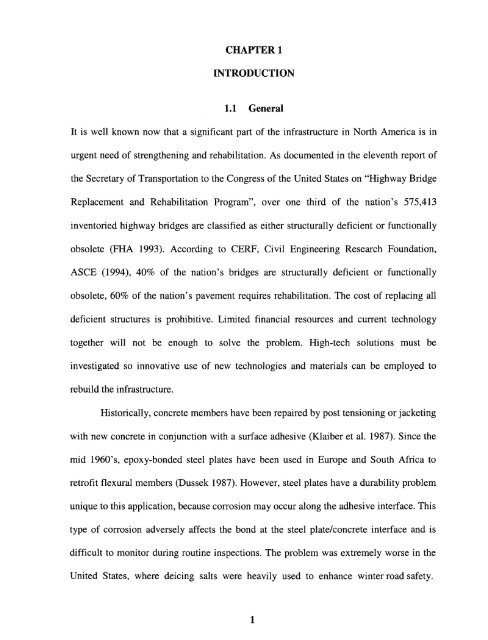njit-etd2003-032 - New Jersey Institute of Technology
njit-etd2003-032 - New Jersey Institute of Technology
njit-etd2003-032 - New Jersey Institute of Technology
You also want an ePaper? Increase the reach of your titles
YUMPU automatically turns print PDFs into web optimized ePapers that Google loves.
CHAPTER 1<br />
INTRODUCTION<br />
1.1 General<br />
It is well known now that a significant part <strong>of</strong> the infrastructure in North America is in<br />
urgent need <strong>of</strong> strengthening and rehabilitation. As documented in the eleventh report <strong>of</strong><br />
the Secretary <strong>of</strong> Transportation to the Oongress <strong>of</strong> the United States on "Highway Bridge<br />
Replacement and Rehabilitation Program", over one third <strong>of</strong> the nation's 575,413<br />
inventoried highway bridges are classified as either structurally deficient or functionally<br />
obsolete (FHA 1993). According to OERF, Civil Engineering Research Foundation,<br />
ASCE (1994), 4O% <strong>of</strong> the nation's bridges are structurally deficient or functionally<br />
obsolete, 6O% <strong>of</strong> the nation's pavement requires rehabilitation. The cost <strong>of</strong> replacing all<br />
deficient structures is prohibitive. Limited financial resources and current technology<br />
together will not be enough to solve the problem. High-tech solutions must be<br />
investigated so innovative use <strong>of</strong> new technologies and materials can be employed to<br />
rebuild the infrastructure.<br />
Historically, concrete members have been repaired by post tensioning or jacketing<br />
with new concrete in conjunction with a surface adhesive (Klaiber et al. 1987). Since the<br />
mid 196O's, epoxy-bonded steel plates have been used in Europe and South Africa to<br />
retr<strong>of</strong>it flexural members (Dussek 1987). However, steel plates have a durability problem<br />
unique to this application, because corrosion may occur along the adhesive interface. This<br />
type <strong>of</strong> corrosion adversely affects the bond at the steel plateiconcrete interface and is<br />
difficult to monitor during routine inspections. The problem was extremely worse in the<br />
United States, where deicing salts were heavily used to enhance winter road safety.<br />
1

















